Free.
Jules Cunningham’s revolutionary style
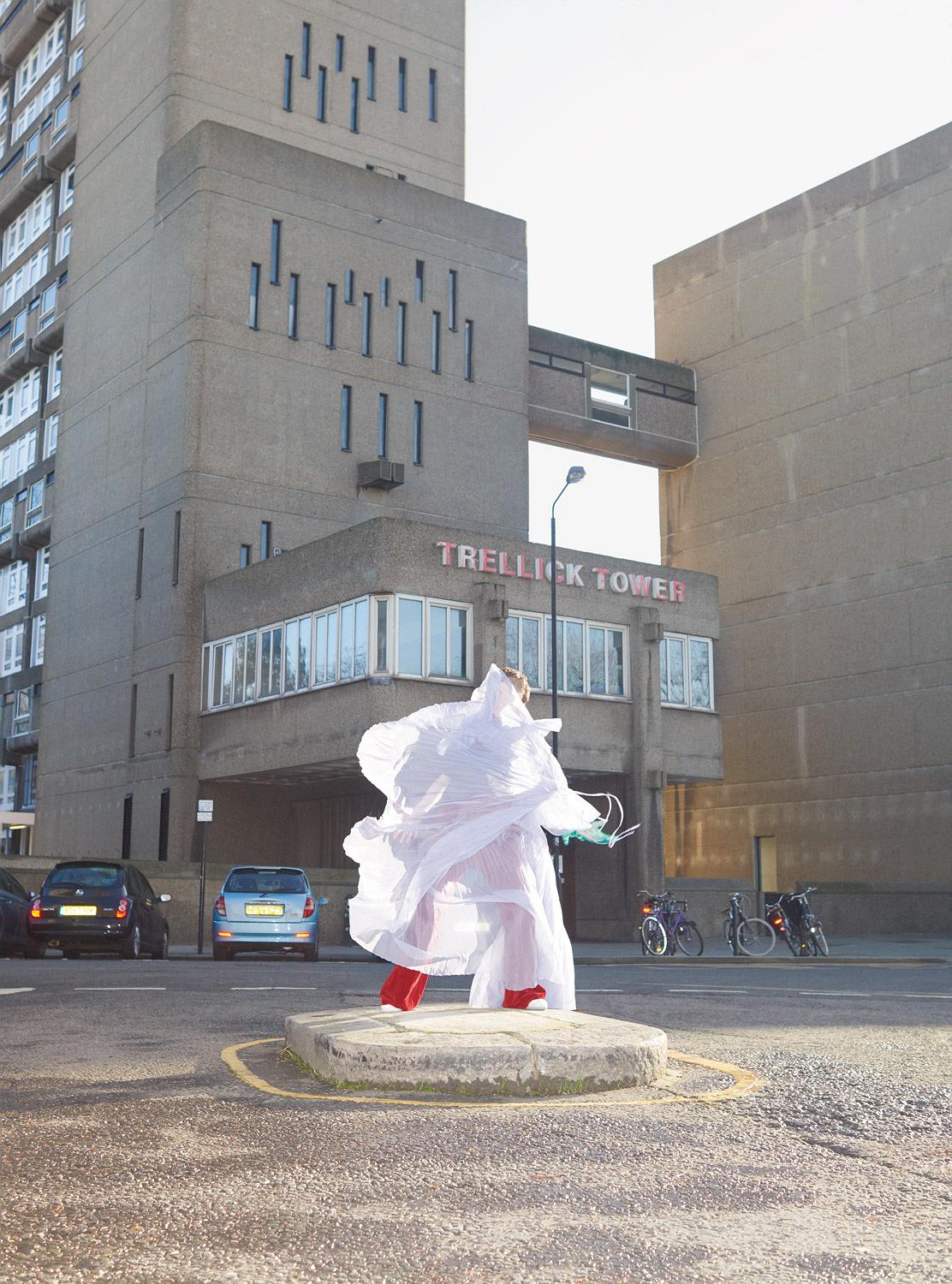
Photography by Johnny Dufort
Styling by Emilie Kareh
Issue nº 21, Spring & Summer 2020
The cerebral shock of Jules Cunningham’s dancing inspires fandom bordering on the fanatical. As an interpreter of Merce Cunningham and Michael Clark’s highly modern visions for dance, the 40-year-old Liverpudlian’s eloquence was second to none. Now, in launching an eponymous company, Jules is getting a chance to tackle the gender constraints that were so confining back in the corps de ballet. And while there are few words to express it, Jules’s message is keenly felt in the visual language of the work.
“Now I’m a choreographer, I realise how important clarity is. I have to find words to explain something there are no words for,” Jules Cunningham says when we meet in mid-December. “I’m trying to get people to understand what I’m asking for and why. I’m always amazed that people will go along with me, even though as a dancer I did it. I just think, ‘What a nice thing for people to offer – themselves.’”
We are at Toynbee Studios, in Whitechapel, across the river from Jules’s home in south-east London, where Julie Cunningham & Company is developing a new piece to music by the pioneering indie-classical composer Nico Muhly. It is part of a commission by the performing arts venue Sadler’s Wells, for which three companies are creating works to accompany Muhly’s genre-defying music. Jules will dance to Drones, music inspired by the constant hum of our domestic environments that Muhly has described as like “singing along to one’s vacuum cleaner”. Jules was made a Sadler’s Wells New Wave Associate in 2018, but even so, this is a prestigious commission, and Jules is trying not to get “freaked out by that. You worry that your work will be seen alongside very established choreographers, and it’s hard to stay cool.”
Dressed in Lycra leggings and a loose cotton T-shirt, Jules’s sinuous, muscled body is both revealed and obscured, their slight five-foot-five frame so eloquent it seems half Giacometti’s “Walking Man”, half elastic band. Julie, 40, identifies as non-binary but describes getting to this point as a slow burn. “Fifteen years ago nobody really talked about non-binary. So I felt like a kind of closet pioneer. I began to say I was genderqueer, but I didn’t think about changing pronouns.”
Nine young dancers peel off layers of winter clothes, stretch necks and limbs, arch feet. Vivaldi’s “Gloria in Excelsis Deo” bursts out of a speaker with such exuberance that everyone laughs. The dancers come together in a circle and shake their bodies, taking their cue from Julie, who jumps about encouragingly and sings along. There is some giggling.
Vivaldi is replaced by the atonal, unpredictable string solos of Drones. Moves are tried and perfected and become sequences, until five pairs of dancers cross the room in a series of waves, bodies bending and falling into one another and out again. Jules occasionally surfaces from a place of concentration to ask if everyone is all right. These sequences are responsive to, but not dictated by, the music. Jules has jotted ideas down in a little black book that they sporadically refer to, “but things never turn out exactly as they were in my head,” they say. The dancers grasp new moves with astonishing speed; Julie demonstrates, encourages and works one-on-one when needed. “The little potato move – is it like this?” one girl asks, and Jules watches before showing her again. Their authority is lightly worn. “I’m aware of experiences I’ve had that were very hierarchical,” they explain. “It’s about respecting how much people are giving. There is a lot of bullying in dance, though I hope that’s changing.”
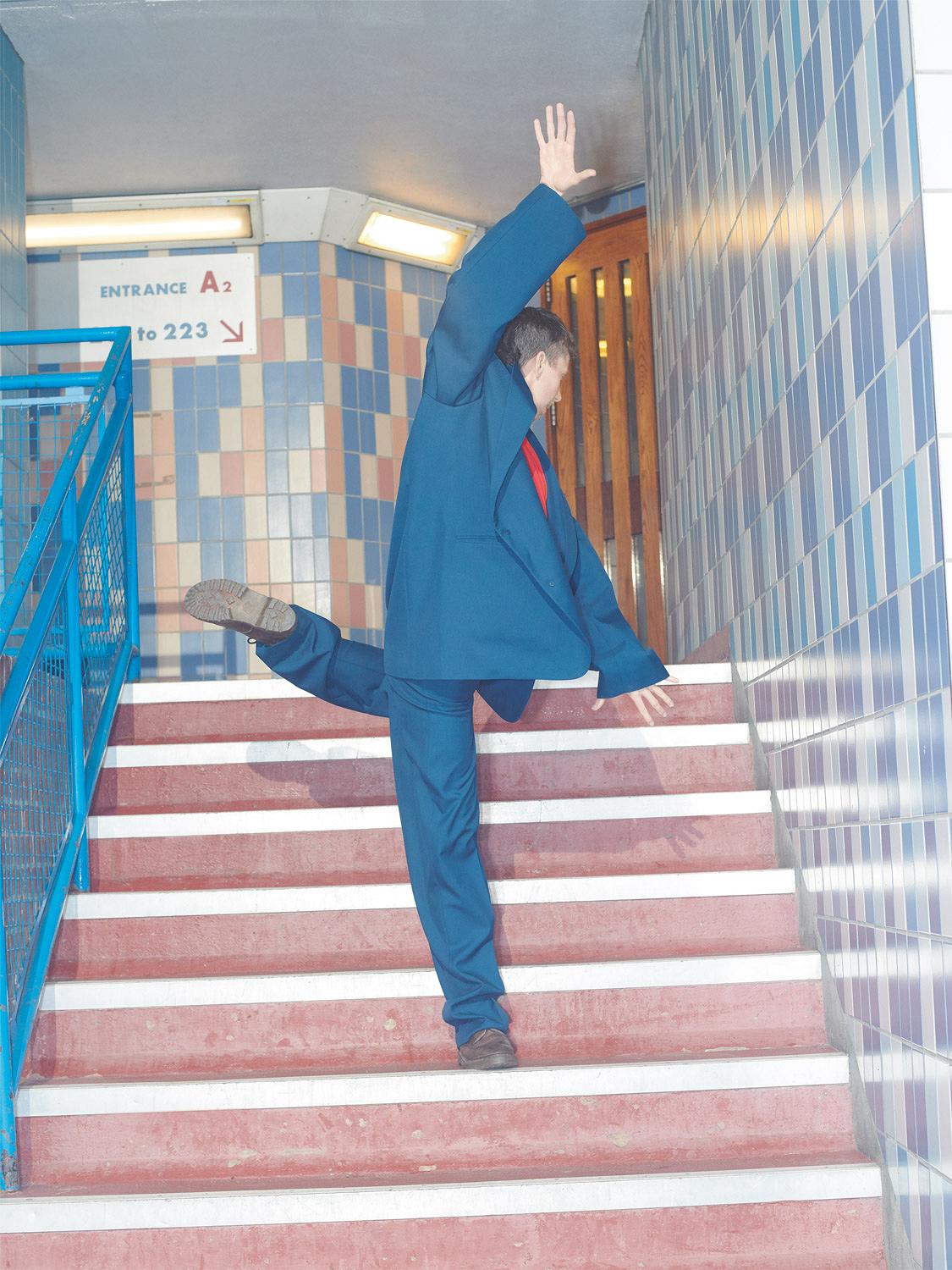
Clothes are treated with playful iconoclasm at Julie Cunningham & Company. Blue tailoring-twill suit by BALENCIAGA; red viscose top by COS. The vintage boots, belt and brooch are all from the Contemporary Wardrobe Collection. In the previous image, lilac silk pleated cape and red velvet trousers both by GUCCI; blue tulle gloves by MARCO DE VINCENZO; vintage trainers from the Contemporary Wardrobe Collection.
Jules was born in Anfield, Liverpool, and moved with their two brothers and parents to St Helens, 11 miles east of the city, when Jules was a small child. At six, they took after-school classes – ballet, modern, jazz and tap. Neither of their parents was interested in dance or the arts, and Jules only went “because a friend was doing it. I think Mum and Dad were pleased I had a hobby, but we were a working-class family and my mum wondered whether dance was a viable career choice.”
Jules was sure their future was in ballet. They had watched The South Bank Show’s programmes on the Royal Ballet principals Sylvie Guillem and Darcey Bussell and “thought they were amazing”. But a Channel 4 programme on dance makers included a segment on Merce Cunningham. “No music in rehearsal! What is this?” Jules recalls thinking. “I wanted to write to him and ask, ‘How do I join your company?’”
Nonetheless, Jules stuck with ballet because “I’d enjoyed it the most, so far” and moved to London at 16 to attend the Central School of Ballet, later describing the experience of being you and alone in a big city as “horrendous”. At 18, they successfully auditioned for Rambert School. In 2002 Jules joined the ballet company of the Stadttheater Koblenz in Germany, where, they say, they danced Sleeping Beauty for six months as “a fairy in a tutu, hair in a bun”.
Soon after leaving Koblenz, Merce Cunningham was on tour in Paris and Jules called the director of the understudy group to ask if they could take a class. He invited them to join the company in New York as an understudy for a six-week stint. They stayed for the best part of a decade.
Revered as the most radical dancer and choreographer of the 20th century, Merce Cunningham reshaped dance into a new art form, challenging traditional notions of storytelling, embracing technology, and collaborating with filmmakers, artists such as Robert Rauschenberg, and composers, including his lifelong partner, John Cage. Rigorous and physically exacting, Merce Cunningham famously did not give feedback. “Years would go by. You wouldn’t know how you were doing; you just told yourself, ‘I’m still here,’” Jules says. Merce Cunningham died in 2009, and Jules stayed with the company for two more years, until a chronic back injury meant prolonged time out.
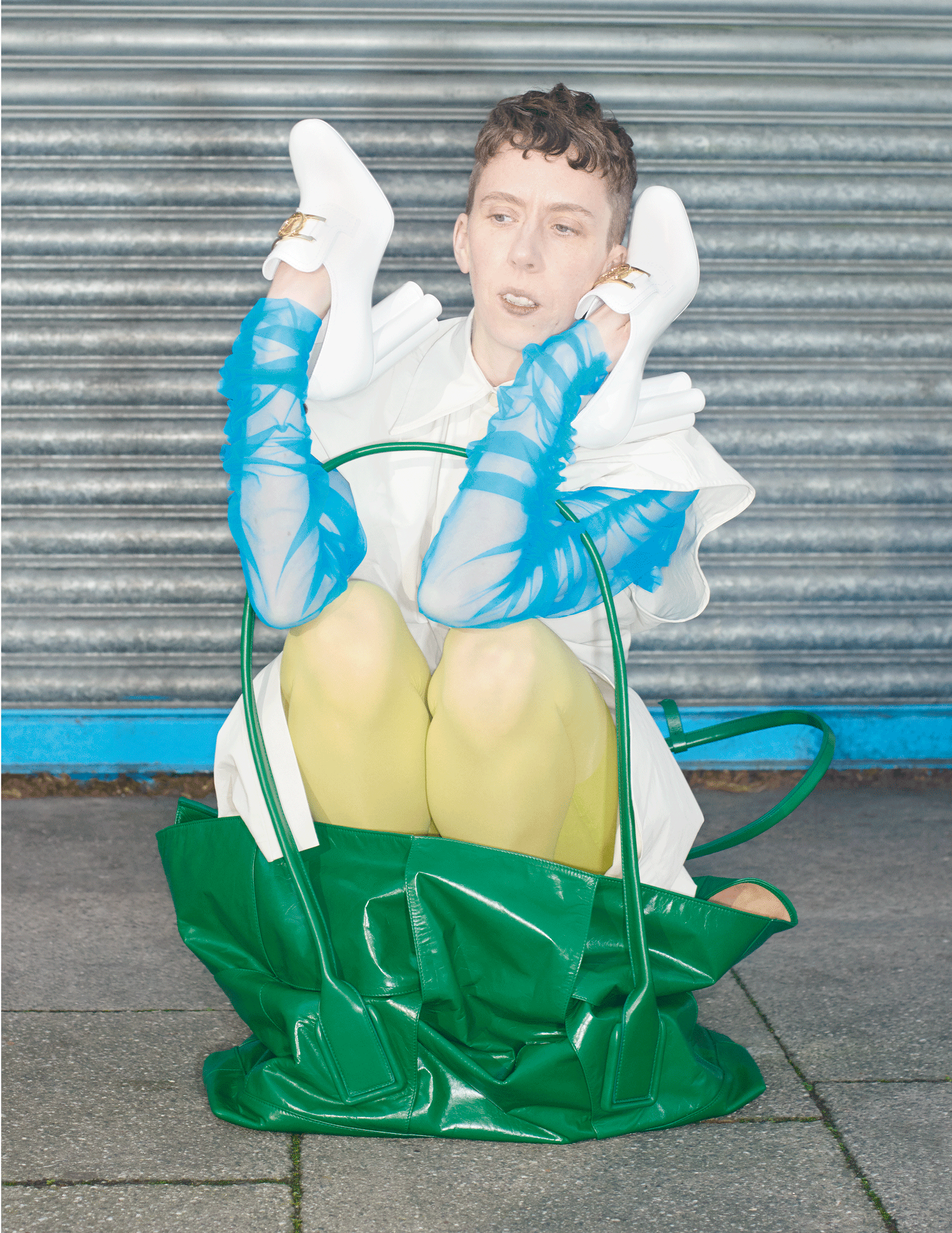
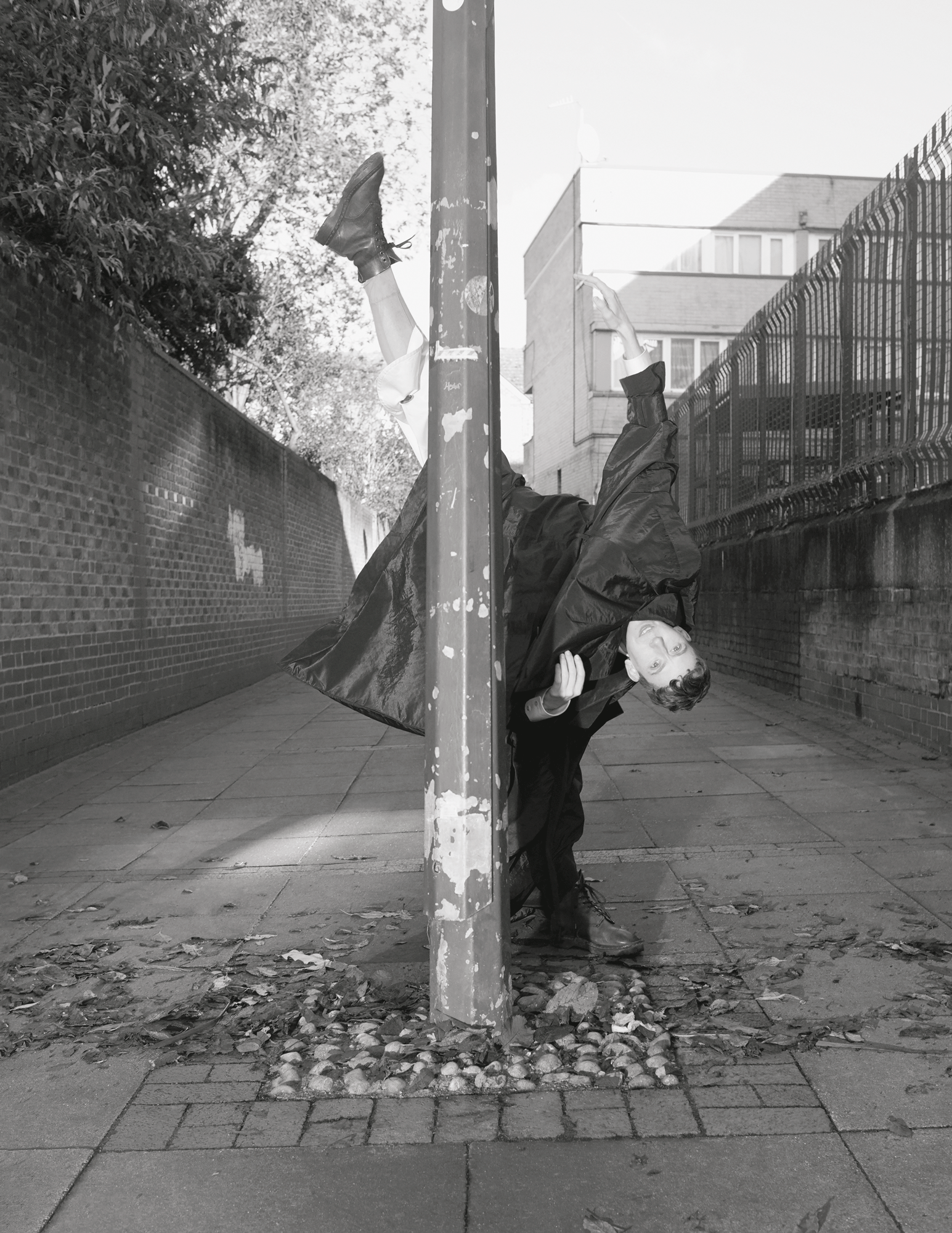
The dancers of Julie Cunningham & Company perform in unisex outfits that are often not designed as dance clothes. On the left, white technical cotton dress by BOTTEGA VENETA; blue nylon top by MOLLY GODDARD. White glazed leather shoes by LOUIS VUITTON, green calf leather bag by BOTTEGA VENETA and yellow tights from FOGAL. On the right, black nylon jacket by Y-3; pink cotton shirt and white cotton trousers by ANDREAS KRONTHALER for VIVIENNE WESTWOOD. Underneath, blue tulle trousers by MARCO DE VINCENZO. Vintage boots and brooch from the Contemporary Wardrobe Collection.
They planned to quit for good – they were already studying at the City University of New York. But the British choreographer Michael Clark invited them to perform, and “I got sucked back in. If there was one thing I wanted to do, it was dance for Michael.” Clark’s austere aesthetic, fine-tuned choreography and ravishing, provocative productions seemed tailor-made for Jules. They spent three and a half years with his company in London, earning themselves a National Dance Award for outstanding modern performance. But despite the privileges of working with such a talent, Jules says they still felt like an object at times – and makes an ironic lift gesture above the cafe table to illustrate their point.
We have met at Sadler’s Wells, where their company is rehearsing today. Dressed in dance kit, Jules gives me a hug, asks for soya milk in their tea and insists on paying. Are they vegan? Can they eat as much as they like? Jules smiles. “I am vegan. I don’t think too much about it. I just eat frequently, every two hours. If I’m working, I never eat a huge meal, just snacks.”
“I know it can seem mysterious, but I don't think you need a language to understand dance.”
Jules starts the morning with a warm-up based on Merce Cunningham’s celebrated daily class. With elements of classical ballet and roots in Martha Graham’s technique, the routine is like a physical meditation, Jules says. “It gets me from waking up unsure of whether I can dance to a place where I’m ready to work.”
In 2016, as the first recipient of Rambert’s Leverhulme Choreography Fellowship, which helps dancers become choreographers, Jules was able to launch their own company. It was only after they stopped dancing with Michael, they say, that they were “able to think about choreography properly. I wanted to see how I would move outside of someone else’s ideas and structures. I’d absorbed Merce’s language, Michael’s language. And I’m still trying to break it all down, not to discard it entirely but to explore it on my own terms.”
Julie Cunningham & Company’s first two dances, Returning and To Be Me, opened at the Barbican in 2017. The latter had as its musical score a recording of the poet Kae Tempest reading from her book Hold Your Own, her take on the Tiresias myth. “We danced to her breath, the flow of the words,” Jules tells me. “Kae is so musical, so rhythmical. But this was my first big piece, so my vocabulary was quite straightforward; I was working things out.” Other productions have included one based on Sarah Kane’s 1998 play Crave, in which four actors who spoke the words were paired on stage with four dancers.
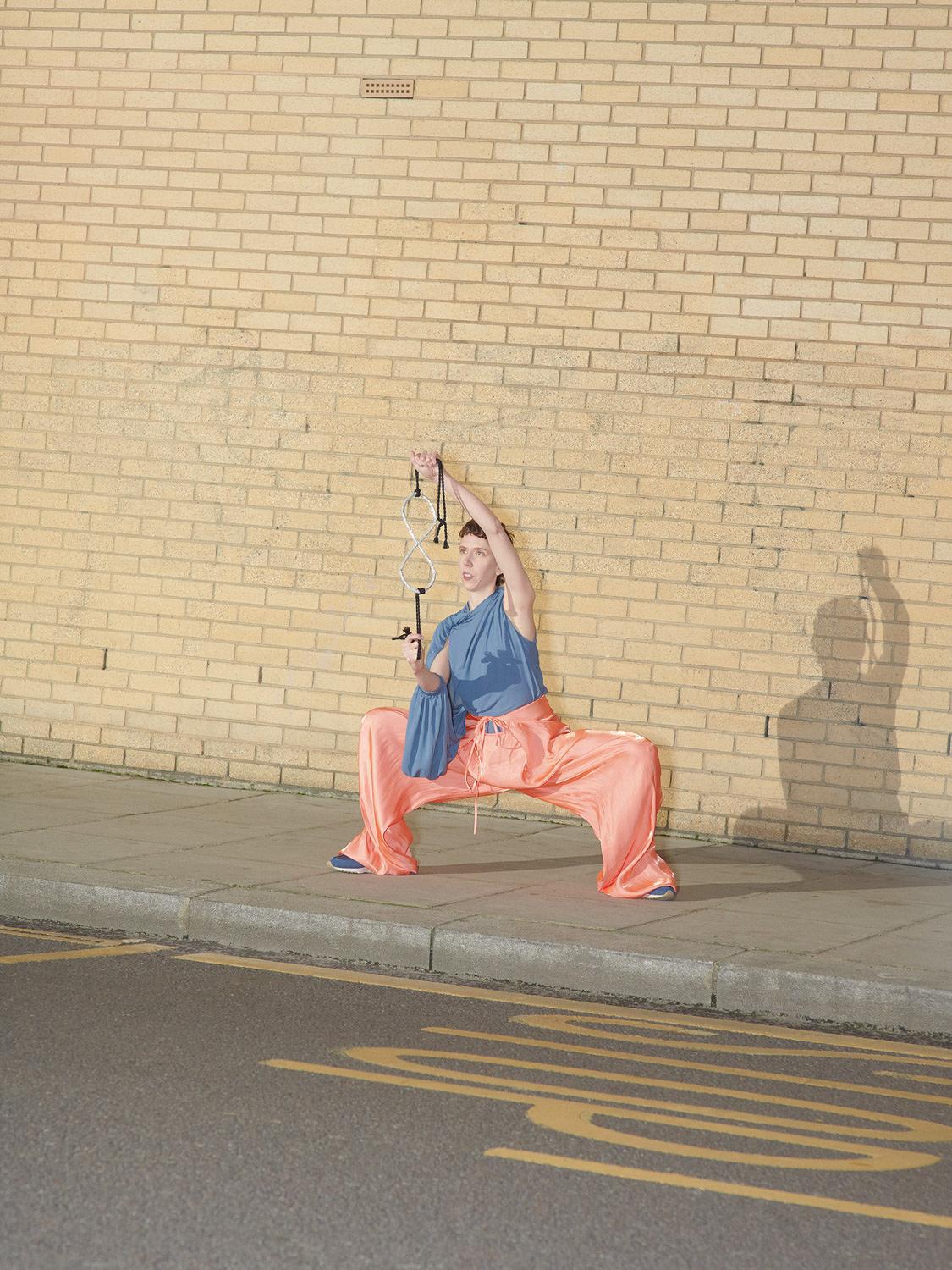
To dance for Julie Cunningham & Company you need to be prepared to go along with their unwavering commitment to an ideal for which there is often scant vocabulary. Blue viscose top and crystal bra top both by JW ANDERSON; apricot liquid-satin trousers by KENZO and trainers by NEW BALANCE.
The power, energy and intellectual dynamism of Merce Cunningham’s and Michael Clark’s practices are evident in Jules’s repertoire, but finding a “softness and ease” is what they are interested in now. Increasingly delicate, with exquisite sequences of jumps and turns that are unbelievably thrilling, the new work is nevertheless rooted in Jules’s study of what it means to be in one’s own body, and this is as political as it is personal.
The exploration and debunking of patriarchal structures and gender stereotyping are fundamental to Jules’s artistic practice, but indirectly. “Ideas are there in the relational and spatial aspects of the work,” they say. “I know it can seem mysterious, but I don’t think you need a language to understand dance. Everyone has a body; everybody can feel.” Equality is at the heart of the company’s ethos, “so that any of us can do anyone else’s part,” Jules adds. “And you don’t have to look like me doing it; you can look like you.”
One of the most difficult things about dance, Jules remarks, is that you only get one shot. “People aren’t going to come back. So the temptation might be to please. But it would feel like I hadn’t done my work. I think it’s demeaning to an audience to make things ‘nice’ for them.”
Sophie HastingsSophie Hastings is a freelance journalist and a contributing editor at GQ, specialising in the international contemporary art scene. She began her journalism career in the rarefied offices of Tatler and Harper’s magazines, before decamping to Paris (via south east Asia), where she got married, learnt…read more Photography by
Johnny DufortJohnny Dufort is known for the wide-ranging use of digital technology in his photography to offer a modernist vision with a surrealist sensibility. Inspired by such diverse and iconoclastic artists as Paul Simon and David Lynch, Johnny has shot campaigns for Stella McCartney, Balenciaga and Louis Vuitton.…read more Styling by
Emilie KarehBorn in Beirut, stylist Emilie Kareh grew up in Paris and London – eventually studying costume and set design at Central Saint Martins. She learned her craft working as an assistant editor at French Vogue straight out of school for 4 years, before launching her own career in the industry. Emilie is…read more
Hair: Soichi Inagaki at Art Partner. Make-up: Janeen Witherspoon at Bryant Artists. Manicure: Pebbles Aikens at the Wall Group. Photographic assistance: David Mannion, Alberto Ferdinando Gualtieri, Pedro Faria, Anna Olszewska. Styling assistance: Elodie Purcell, Federica Battistino. Production: Farago Projects.
This profile was originally published in The Gentlewoman nº 21, Spring & Summer 2020.